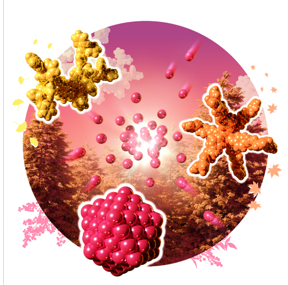Home > Press > Atom by atom: building precise smaller nanoparticles with templates
 |
| This scientific illustration of the study, created by Dr Takamasa Tsukamoto of Tokyo Tech, was selected as an Inside Cover Picture in Angewandte Chemie International Edition. Image source: Dr. Tsukamoto, Tokyo Tech
CREDIT Dr Takamasa Tsukamoto of Tokyo Tech |
Abstract:
Nanoparticles (which have sizes ranging between 3500 nm), and sub-nanoclusters (which are around 1 nm in diameter) are utilized in many fields, including medicine, robotics, materials science, and engineering. Their small size and large surface-area-to-volume ratios give them unique properties, rendering them valuable in a variety of applications, ranging from pollution control to chemical synthesis.
Atom by atom: building precise smaller nanoparticles with templates
Tokyo, Japan | Posted on March 4th, 2022
Recently, quasi-sub-nanomaterials, which are about 1-3 nm in scale have attracted attention because they have a dual naturethey can be regarded as nanoparticles, as well as inorganic molecules. Understandably, controlling the number of atoms in a quasi-sub-nanomaterial could be of much value. However, synthesizing such precise molecular structures is technically challengingbut scientists at Tokyo Tech were certainly up for this challenge!
Dendrons highly branched molecular structures consisting of basic imines have been suggested as precursors for the precise synthesis of quasi-sub-nanomaterials with the desired number of atoms. The imines in the dendrons function as a scaffold that can form complexes with certain acidic metallic salts, accumulating metals on the dendron structure. These, in turn, can be reduced to metal sub-nanoclusters with the desired number of atoms. However, synthesizing dendrons with a high proportion of imines is an expensive process with low yield.
Now, in a study published in Angewandte Chemie, the researchers explain how they have combined multiple dendrimer structures to form a supramolecular capsule composed of more than 60 imines. The synthesis of dendron-assembled supramolecules was accomplished by connecting internal core units and external dendron unitswhich determine the central structure and terminal branches, respectively, explains Assistant Professor Takamasa Tsukamoto, who was involved in the study. The internal structure of this supramolecule contained a six-pronged core with acidic tritylium, while each outer unit contained dendrons with imines. The interaction between the acidic core and the basic outer structure resulted in a self-assembling organo-complex.
Moreover, the imines were found to co-accumulate with rhodium salts such that the innermost imines formed a complex with tritylium units while the outermost ones were populated with the rhodium salts. The resulting supramolecule, which had an internal core unit surrounded by six external dendron units (each containing 14 rhodium salts at the outer imines), was successfully condensed to clusters containing 84 rhodium atoms having a size of 1.5 nm.
By attaching imine containing dendrons to an acidic core, the researchers constructed a supramolecular template for the synthesis of quasi-sub-nanomaterials. Moreover, since the imines can form complexes with a wide range of cationic units, the method can be used to synthesize a variety of supramolecular structures. Due to its versatility, simplicity and cost-effectiveness, the method can be a cornerstone for the development of new nanomaterials. This novel approach for obtaining atomicity-defined quasi-sub-nanomaterials without the limitations of conventional methods has the potential to play an important role in exploring the last frontiers of nanomaterials, says Prof. Tsukamoto. Indeed, this may be a small step for Tokyo Tech, but a giant step for nanoscience!
####
For more information, please click here
Contacts:
Kazuhide Hsegawa
Tokyo Institute of Technology
Copyright © Tokyo Institute of Technology
If you have a comment, please Contact us.
Issuers of news releases, not 7th Wave, Inc. or Nanotechnology Now, are solely responsible for the accuracy of the content.
News and information
![]()
Visualizing the invisible: New fluorescent DNA label reveals nanoscopic cancer features March 4th, 2022
![]()
OCSiAl receives the green light for Luxembourg graphene nanotube facility project to power the next generation of electric vehicles in Europe March 4th, 2022
Nanofabrication
![]()
Review on the femtosecond laser precision micro/nano-engineering December 3rd, 2021
![]()
Patterning silicon at the one nanometer scale: Scientists engineer materials electrical and optical properties with plasmon engineering August 13th, 2021
![]()
New tech builds ultralow-loss integrated photonic circuits April 16th, 2021
![]()
Kirigami-style fabrication may enable new 3D nanostructures April 2nd, 2021
Possible Futures
![]()
Superb switching uniformity of RRAM with localized nanofilaments of wafer-scale Si subulate array March 4th, 2022
Self Assembly
![]()
Nanostructures get complex with electron equivalents: Nanoparticles of two different sizes break away from symmetrical designs January 14th, 2022
![]()
3D design leads to first stable and strong self-assembling 1D nanographene wires April 6th, 2021
![]()
DNA–Metal double helix: Single-stranded DNA as supramolecular template for highly organized palladium nanowires March 26th, 2021
Discoveries
![]()
Measuring pulse waves with a hair-thin patch March 4th, 2022
![]()
Visualizing the invisible: New fluorescent DNA label reveals nanoscopic cancer features March 4th, 2022
Announcements
![]()
Visualizing the invisible: New fluorescent DNA label reveals nanoscopic cancer features March 4th, 2022
![]()
OCSiAl receives the green light for Luxembourg graphene nanotube facility project to power the next generation of electric vehicles in Europe March 4th, 2022
Interviews/Book Reviews/Essays/Reports/Podcasts/Journals/White papers/Posters
![]()
Superb switching uniformity of RRAM with localized nanofilaments of wafer-scale Si subulate array March 4th, 2022
![]()
Measuring pulse waves with a hair-thin patch March 4th, 2022
Nanobiotechnology
![]()
Measuring pulse waves with a hair-thin patch March 4th, 2022
![]()
Visualizing the invisible: New fluorescent DNA label reveals nanoscopic cancer features March 4th, 2022










